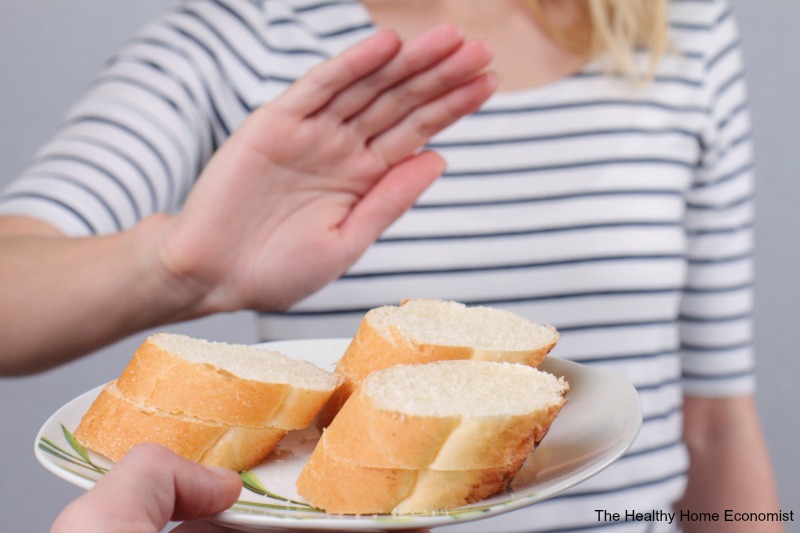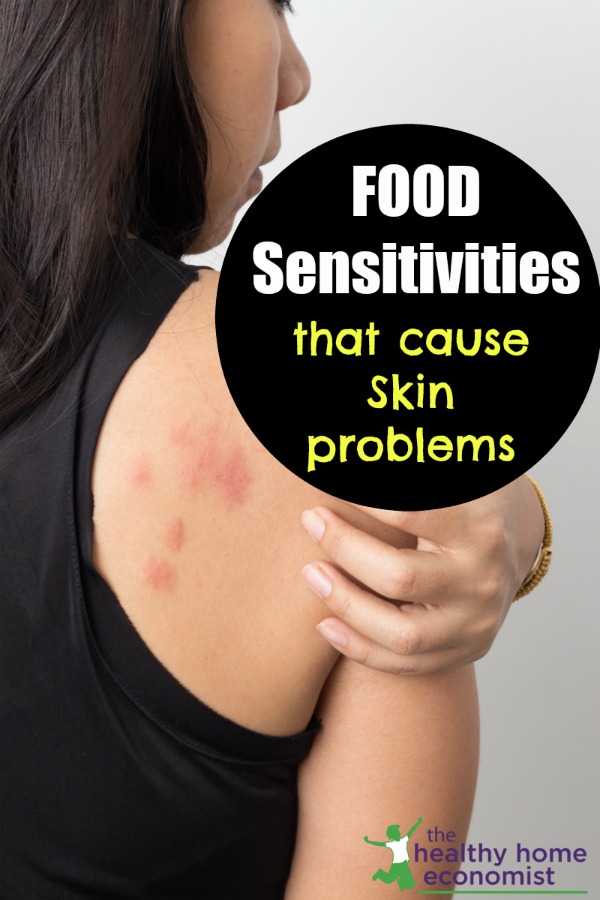Table of Contents[Hide][Show]

Food sensitivities are dramatically on the rise and the same can be said for skin disorders. Looking back even a decade ago, being sensitive to some kinds of food was not the hot topic that it is today. Going back 50 years ago, it was virtually unheard of!
For example, the “trend” we are seeing among people going wheat and gluten-free is proof of this. The truth is this is not a trend that is going to go away anytime soon. According to gluten specialist, Dr. Tom O’Bryan, 7 out of 10 people have a sensitivity to gluten whether they know it or not.
That surely sounds like an epidemic to me!
Just because someone is not diagnosed with Celiac disease doesn’t mean that there isn’t a problem. Like with any diagnosis, gluten intolerance doesn’t develop overnight, and in time, the sensitivity could progress drastically if intervention is not taken.
It’s also worth noting that for every person who has gluten sensitivity with gut dysfunction symptoms, there are 8 that don’t. Like with any food sensitivity, we cannot assume that it will only affect us in one way.
Most think of gluten as a “gut issue”, but this is not necessarily so. Food sensitivity symptoms, like gluten, can manifest in different ways for different people.
The big picture is that there are typically multiple food sensitivities in a single individual with this problem. It’s very rare that I see people with just one food sensitivity in my practice, which is much different than a true food allergy.
True Food Allergy vs Food Sensitivity?
A food allergy has an immediate response on the body. It can be potentially deadly and trigger instant symptoms such as a rash, itching, swelling, wheezing etc. The most common food allergies are shellfish and or fish, peanuts, nuts, soy, dairy, and eggs. Food sensitivities and intolerances are far more common than allergies.
Unlike a food allergy, a sensitivity could take up to 72 hours for symptoms to show.
The list of potential symptoms is almost endless, as a food sensitivity can manifest in many different forms. Some of the most common food sensitivity symptoms include:
- Skin conditions such as acne, eczema, psoriasis, rashes, rosacea
- Digestive Distress: constipation, diarrhea, cramping, bloating, gas
- Headaches/ Migraines
- Fatigue/ low energy
- Difficulty losing weight/ obesity
- ADD/ ADHD
- Arthritis
- Ear infections
- Sinus Infections
- Achy and painful joints
… To name but a few!
The tricky thing about food sensitivities is that they can be perfectly healthy whole foods; foods that we would not normally suspect to be a problem!
As I have discussed in prior articles about the importance of gut health to clear skin, a damaged gut is a breeding ground for food sensitivities.
There are particular foods that can aggravate an already irritated stomach, and/or prevent it from healing, as well as create even more inflammation throughout the body.
Foods that Affect the Skin
The following foods, in particular, are those that tend to affect the skin. Note that everyone is different, however. Some may only be sensitive to some, while others may be sensitive to all!
- Wheat/Gluten
- Grains (authentic sourdough may be tolerated)
- Dairy (raw dairy, ghee, and butter may be exceptions)
- Eggs (typically the white rather than the yolk)
- Nuts (soaked/sprouted nuts may be tolerated)
- Soya including all types of edamame
Many will see a huge change in their skin after removing these foods from their diet. If still no difference is noticed, consider specific food groups that are also known to exacerbate symptoms:
Nightshades
Nightshades are a group of foods known to increase inflammation in the body, and because most skin issues are inflammatory conditions, eliminating these can also be a step to relieve symptoms. These typically include potatoes, tomatoes, sweet and hot peppers, eggplant, tomatillos, tamarillos, pepinos, pimentos, paprika, and cayenne peppers.
Histamine containing foods
The process of fermentation produces histamine, and some are more sensitive to this than others, especially if they already have a build-up of it in their system. For some, the bacteria in their gut may be producing excess histamine.
This may also be why certain people cannot tolerate fermented foods. Although it may be impossible to completely avoid histamine, following a low histamine diet may be helpful for some. This is a partial list of common foods that are high in histamine: (1)
- Alcoholic beverages, especially beer and wine.
- Anchovies
- Avocados
- Cheeses, especially aged cheese, such as parmesan, blue, and Roquefort.
- Cider and other homemade fermented beverages such as homemade root beer.
- Dried fruits such as apricots, dates, prunes, figs, and raisins (you may be able to eat these fruits – without reaction – if the fruit is thoroughly washed).
- Eggplant
- Fermented foods, such as pickled or smoked meats, sauerkraut, etc.
- Mackerel
- Mushrooms
- Processed meats – sausage, hot dogs, salami, etc.
- Sardines
- Smoked fish – herring, sardines, etc.
- Sour cream, sour milk, buttermilk, kefir, yogurt – especially if not fresh.
- Soured breads, such as pumpernickel, coffee cakes and other foods made with large amounts of yeast.
- Spinach, tomatoes
- Vinegar or vinegar-containing foods, such as mayonnaise, salad dressing, ketchup, chili sauce, pickles, pickled beets, relishes, olives.
- Yogurt
FODMAP Foods
FODMAP stands for Fermentable Oligosaccharides, Disaccharides, Monosaccharides And Polyols. Like histamine that can be produced by gut bacteria, because these carbohydrates are not completely broken down and absorbed in the GI tract, they can cause fermentation and symptoms such as diarrhea, pain, and gas in some people.
You may already be familiar with the GAPS diet, or the Specific Carbohydrate diet to address gut dysfunction. Avoiding foods that contain these sugars may also be an additional approach, or one on it’s own to consider, especially if you already have a gut diagnosis such as colitis or IBS. (2)
It’s possible to be intolerant to several different foods. Start with the major sensitivities above and begin to eliminate one food group at a time. Give your body at least 1-3 months to see results. If no large improvements, move on to the next group. For a quick at-home test to check for food sensitivities, try the pulse testing allergy method.
Summary
Although these three categories are typically the largest culprits for people in terms of skin irritants in the diet, food sensitivities could also be any random food, especially if digestion is not working optimally.
These are general recommendations I have established from my research, working with clients, and personal experience. While not everyone will have to remove everything suggested here, some may be hypersensitive to many foods, and in that case further investigation may be needed, as well as working with a practitioner that can cater to your body’s needs.

References
(1) Histamines in Food
(2) Fermentable oligosaccharides, disaccharides, monosaccharides and polyols (FODMAPs) and nonallergic food intolerance: FODMAPs or food chemicals?








I get a terrible rashes break out on my back ,chess, arms every time afterwards eating meats sometimes the rash get to my hands and thighs my blood pressure goes very high my breathing got short i have doing this also irregularly heart beats seafood only agreed with me
Drs. told me they never heard meats to break a person out my answer for that diagnose no answers why I need help for this problem
How long do you have to give up the foods? My daughter gets pinpoint raised red bumps only around her mouth after eating pasta and grains and raspberries. She also suffers from constipation but a probiotic is helping her go every other day.
I have experienced this exactly! Not eating gluten and dairy makes your skin so much more beautiful it’s unreal.
Donna Sweet Jerry Sweet
JeremiahandAshley Griffin might be interested?
F
My son’s keratosis pilaris and cracking heels (he’s 3) led me to get him allergy tested. He turned up allergic to wheat (we’re already GF), eggs and dairy. Since removing eggs the KP cleared up.
Thank you
Thank you
I KNOW that I have significant issue with several of the histamine containing foods. So, is it reasonable to start by eliminating those foods first before eliminating something as common as gluten? I have such a difficult time planning 2 meals per week for my little family that eliminating significant nutrition sources sounds almost impossible. Help!